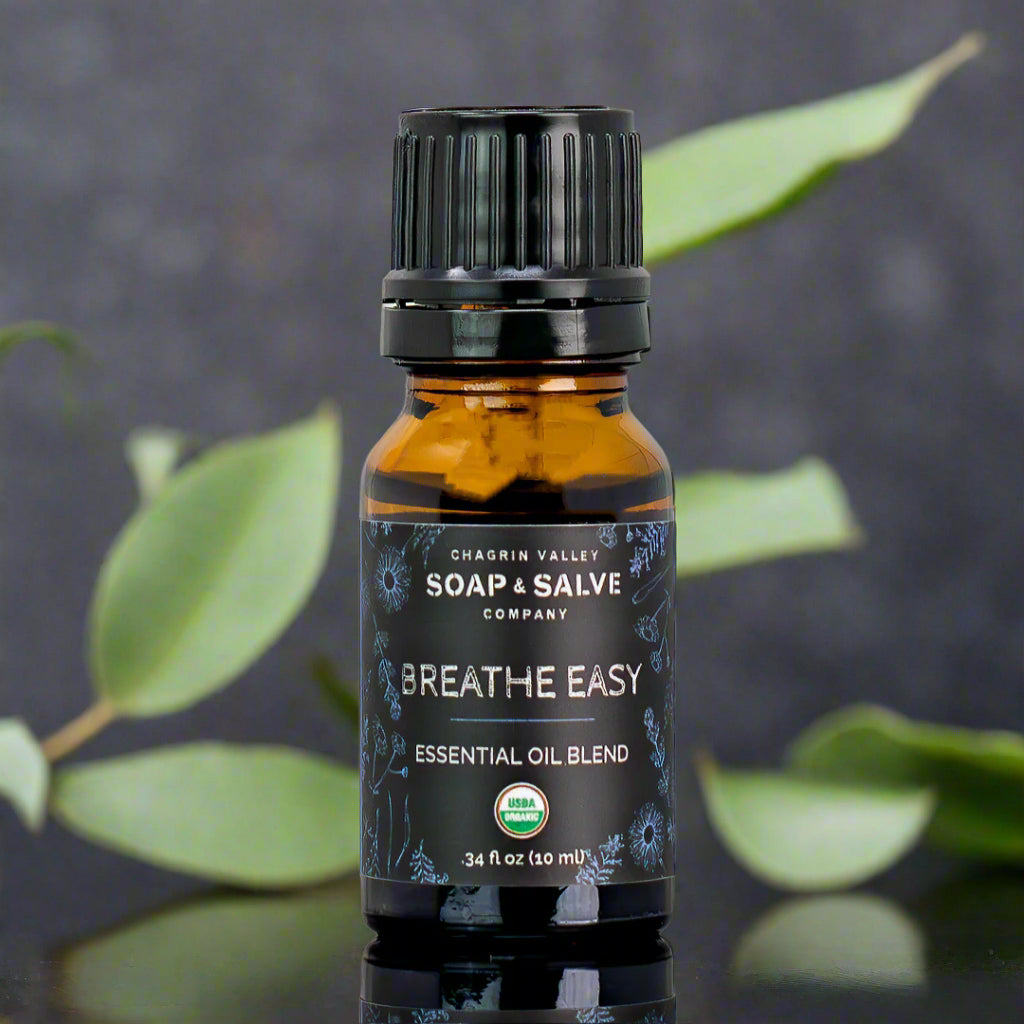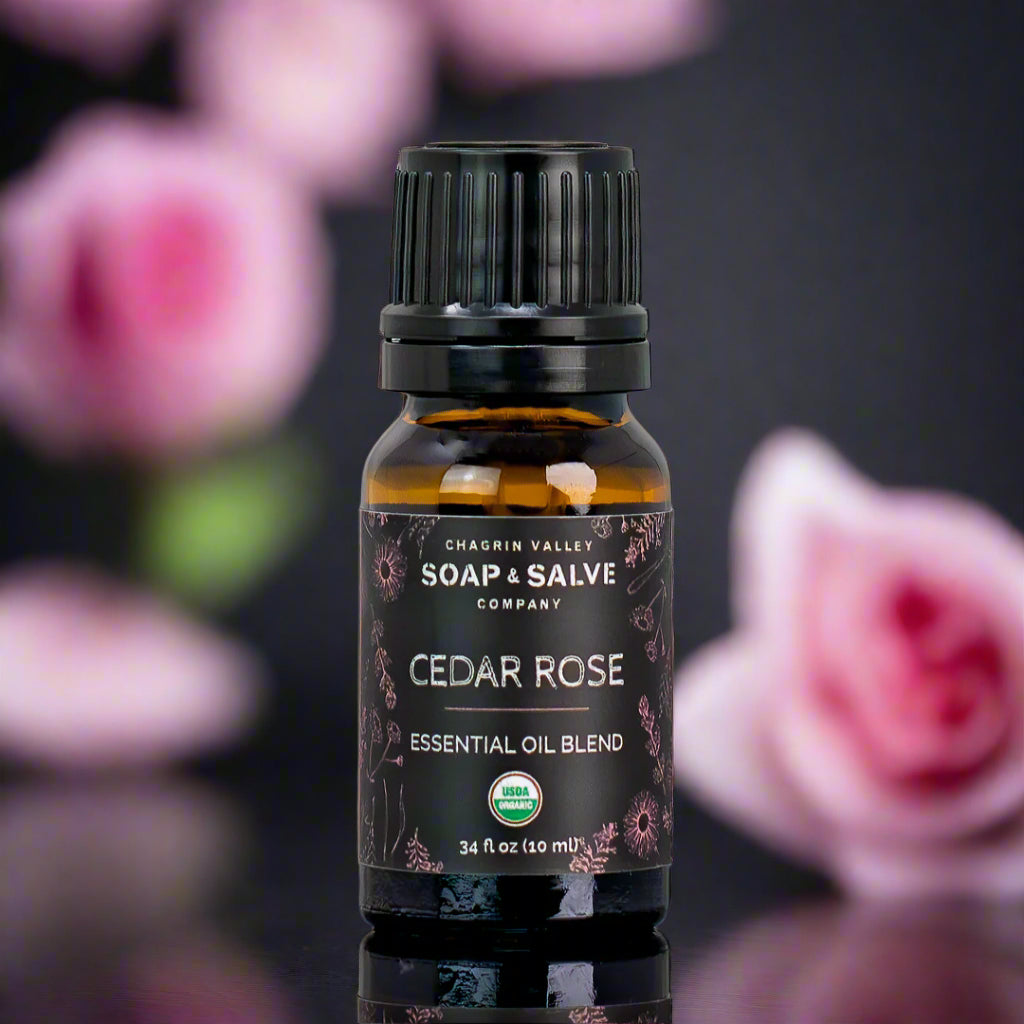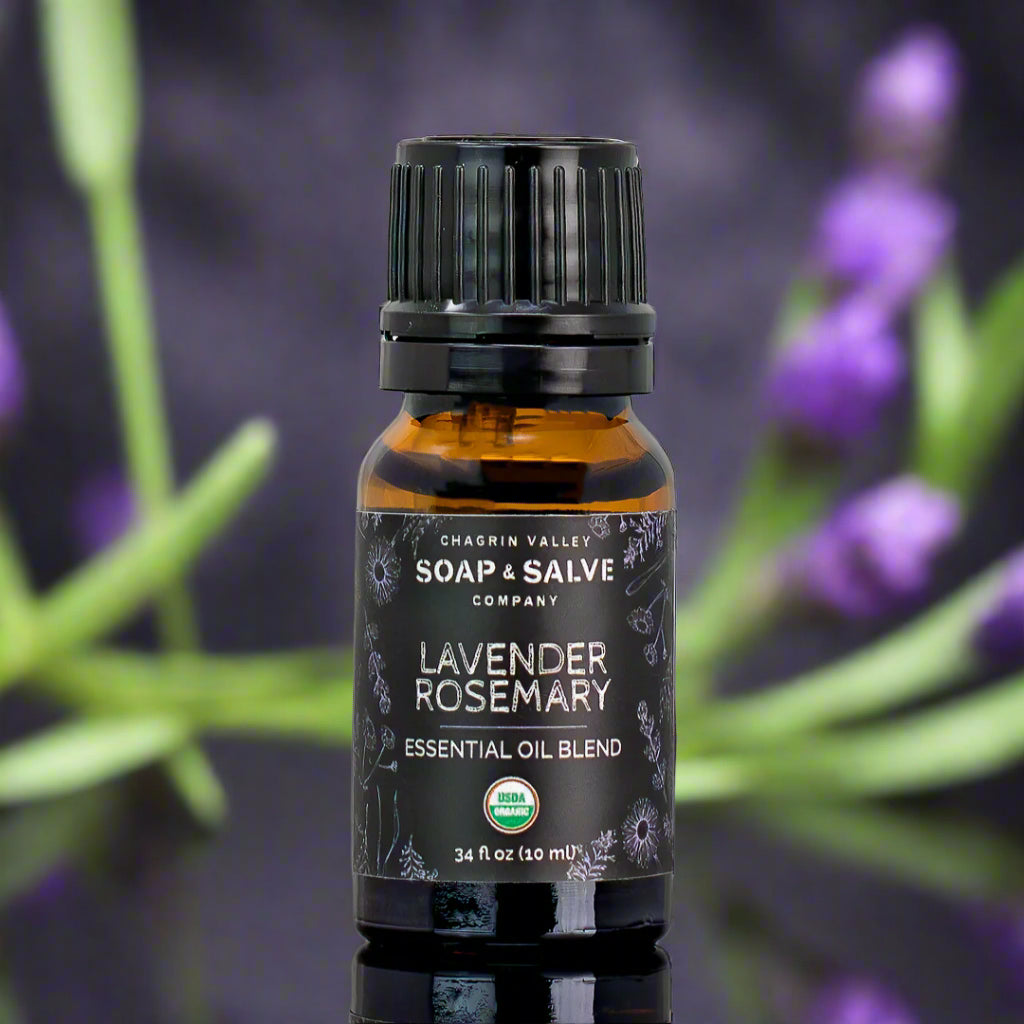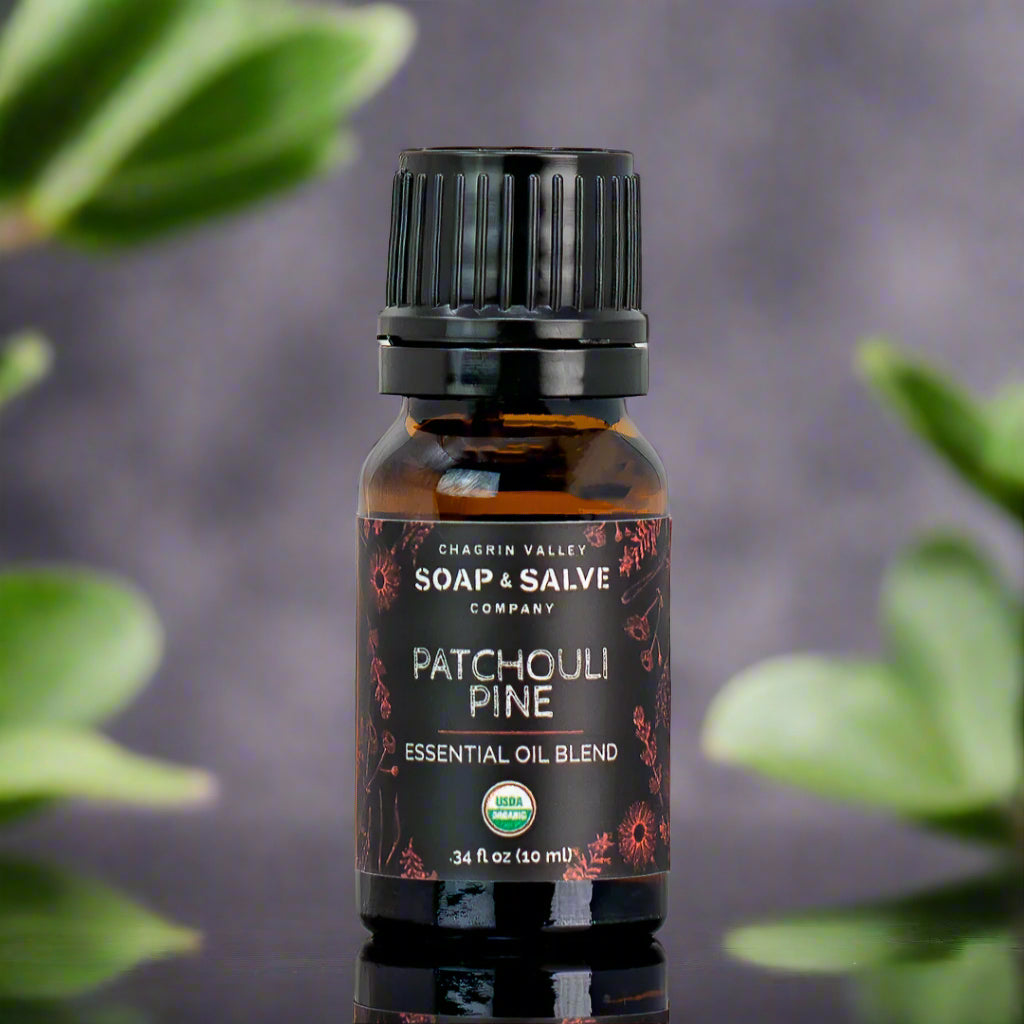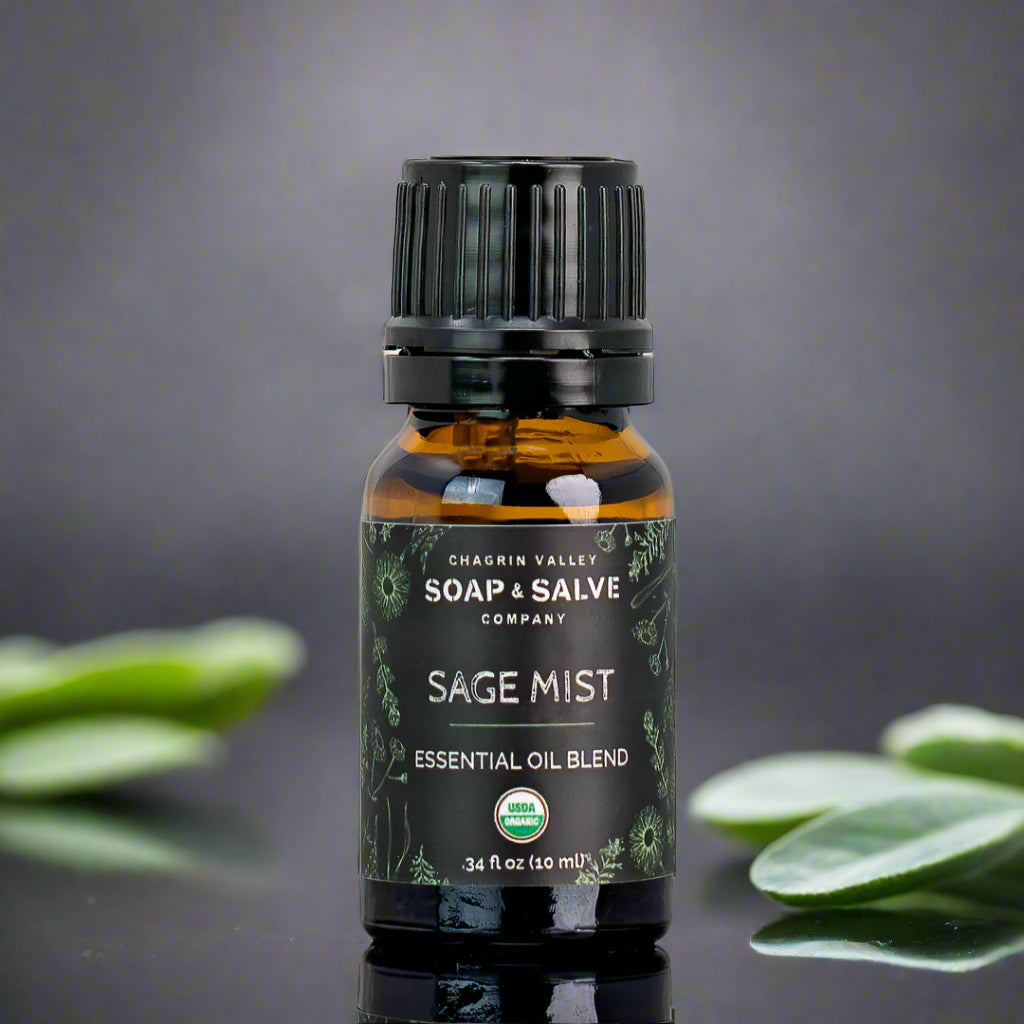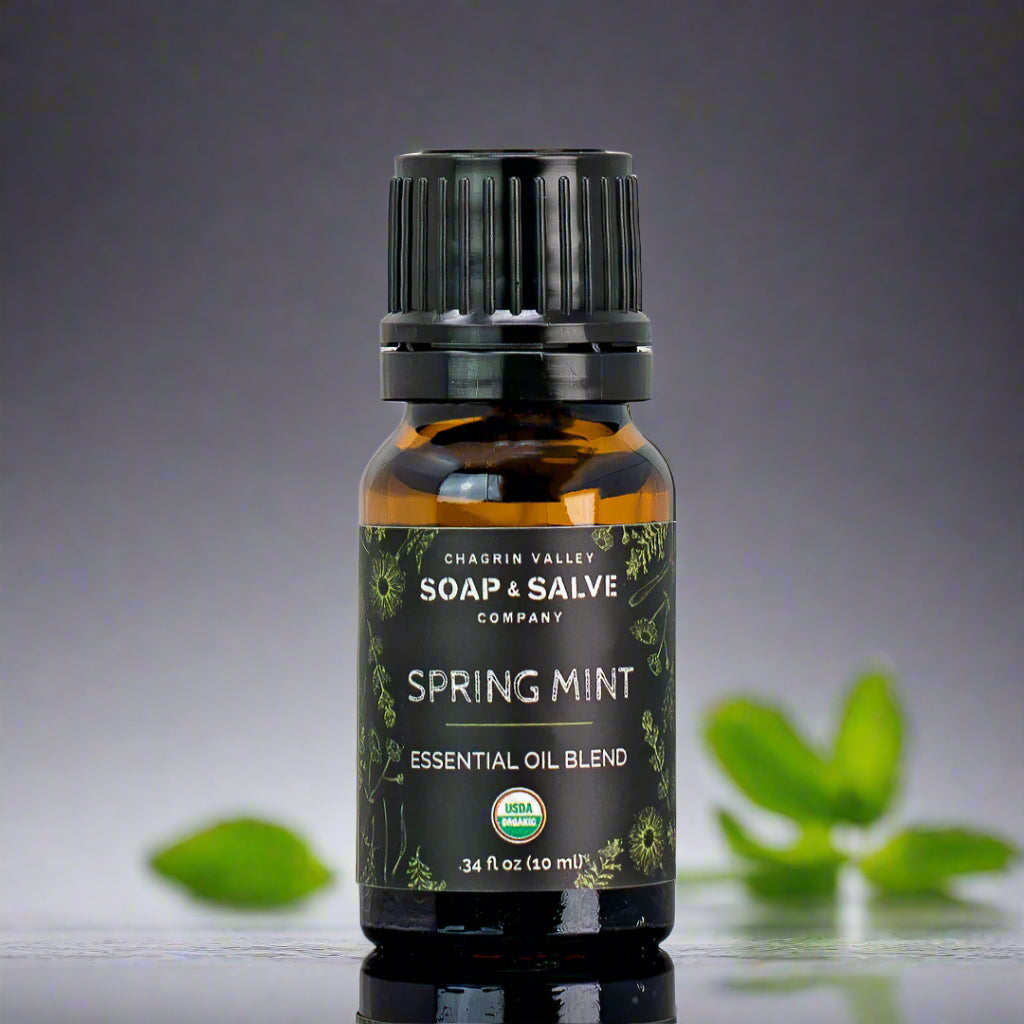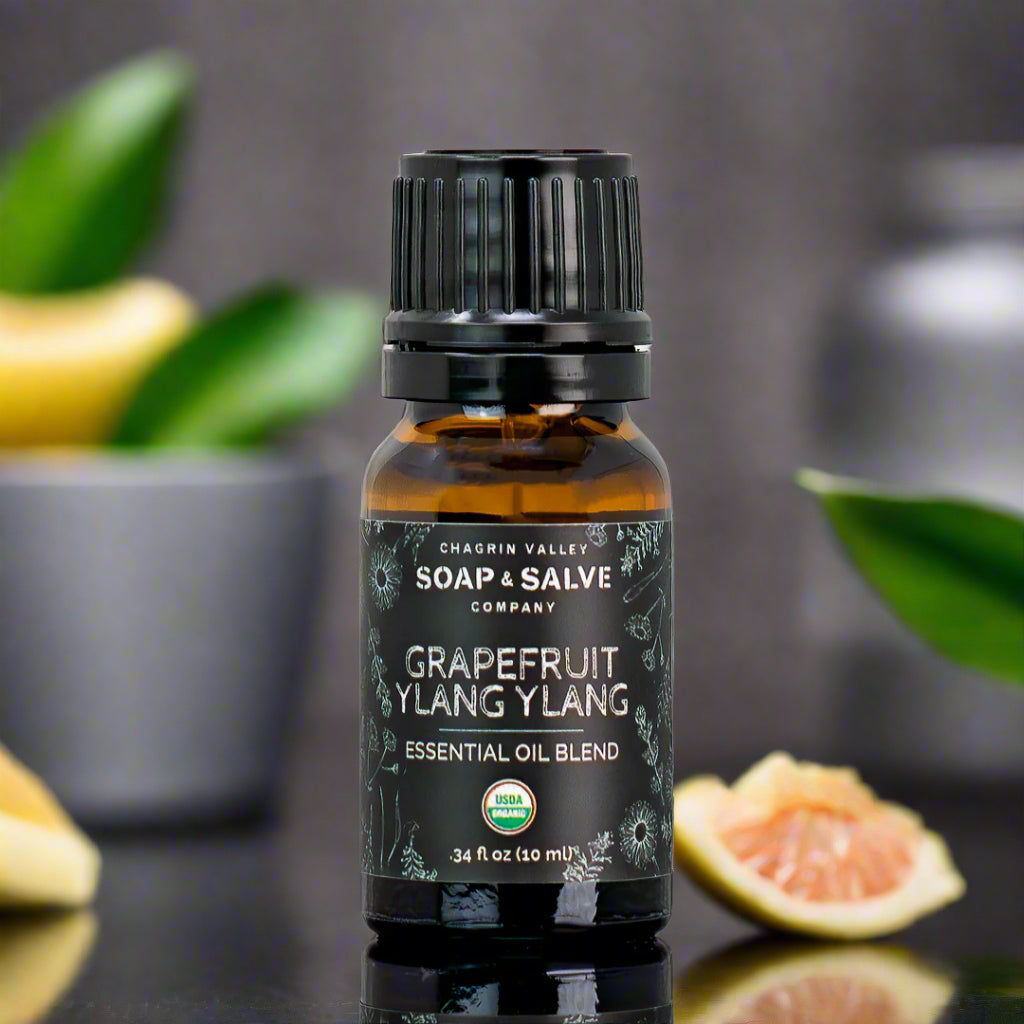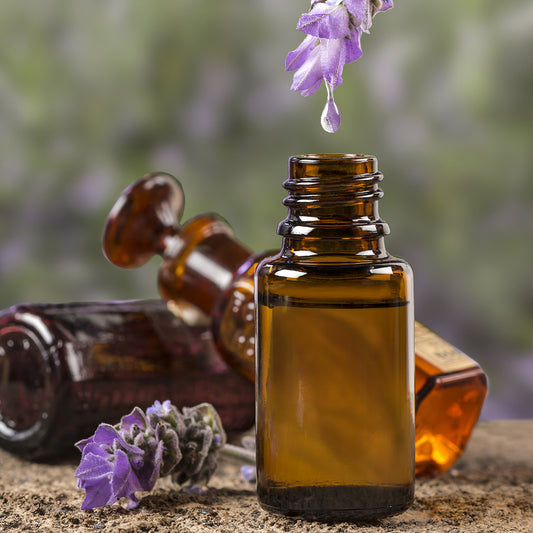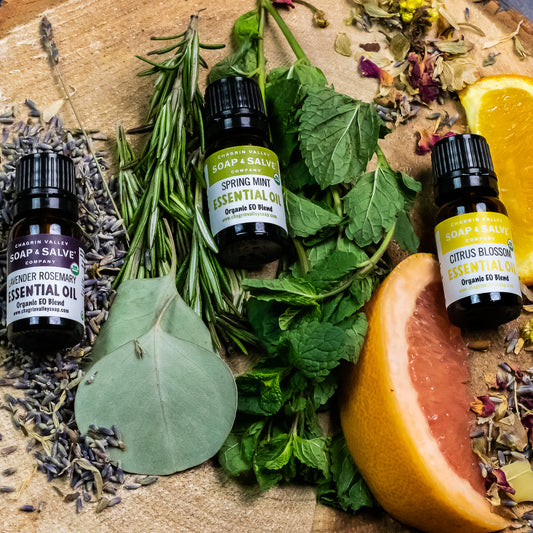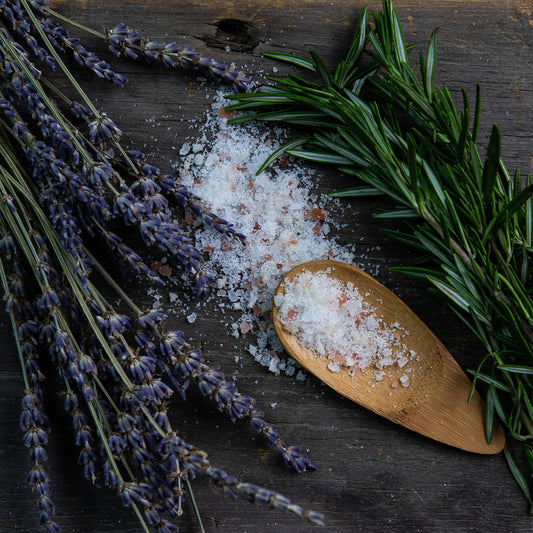Essential Oil Basics: A Guide To Carrier Oils
This is the first part of a two-blog series. The second blog discusses dilution rates for essential oil.
When first venturing into the world of essential oils you will likely read the words, “dilute in a carrier oil” over and over again. In this blog, I would like to discuss carrier oils.
If you have been using essential oils for a while, you are probably already using carrier oils. For those new to essential oils, a carrier oil is a base oil used to dilute essential oils before they are applied topically (to the skin).
Before we begin learning about dilution rates and carrier oils, it is important to review a little bit about essential oils. I have written numerous blogs on a variety of essential oil topics and I will provide the links for a more in-depth look.
What Are Essential Oils?
Powerfully fragrant, essential oils are the concentrated essences of the natural aromatic compounds found in leaves, flowers, stems, roots, bark, resin, seeds of plants, or the peel of a fruit.
Learn More: Read our blog, "What Are Essential Oils?"
 True essential oils are either steam distilled or cold-pressed from the source plant.
True essential oils are either steam distilled or cold-pressed from the source plant.
Learn More: Read our blog, "How Are Essential Oils Extracted?"
Essential oils have been used for thousands of years for many things from medicine and health to religious and spiritual ceremonies. The simple aroma of essential oils can affect our mood.
When we inhale through our nose, the scent molecules in essential oils travel across millions of tiny olfactory neurons that sit on the roof of the nasal cavity. These neurons activate regions in the limbic system of the brain associated with memory, emotion, and state of mind.
Learn More Blog: “What is Aromatherapy?”
Why do we Need to Dilute Essential Oils?
Essential oils are about 80 to 100 times more potent than the botanicals from which they are extracted.
For example, it takes about 220 pounds of lavender flowers to produce one pound of lavender essential oil and about 100 lemons to produce one ounce of lemon essential oil.
These concentrated oils have the potential to irritate the skin. Diluting essential oils prior to topical use helps minimize the risk of skin irritation or sensitization.
What Are Carrier Oils?
Unlike essential oils which are distilled or expressed from the aromatic components of a plant, carrier oils are derived from oily seeds, kernels, or nuts.
At this point you may be asking, aren't these the same types of oils I use for cooking? The simple answer is, yes. When talking about these oils in the skincare industry they are usually referred to as fixed oils or carrier oils. When used with essential oils the name "carrier" oil makes sense. These oils help "carry" the concentrated essential oils onto the skin without changing their therapeutic properties.
Carrier oils are the easiest way to dilute concentrated essential oils so that they be safely applied to the skin, but they are not all alike.
Each oil contains different fatty acids and nutrients and has its own set of therapeutic properties. We are often so focused on the essential oils that we overlook the benefits of carrier oils.
- Carrier oils offer their own therapeutic benefits to any skincare regimen.
- Carrier oils allow you to apply essential oils over a larger area of skin, which can help increase absorption.
- Essential oils are very volatile, meaning they evaporate quickly. Carrier oils help slow evaporation which helps the scent to linger for a longer period of time.
Why do we need an OIL? Essential oils are soluble (will dissolve) in carrier oils and alcohol. Since you are not going to use alcohol as a base for a skincare product, carrier oils are the perfect option.
Also note that essential oils are insoluble (do NOT dissolve) in water or water-based liquids like hydrosols, milk, aloe, or even witch hazel. When mixed with a water-based ingredient the molecules of the essential oil will float in tiny droplets on the surface (think of oil droplets on the surface of the water).
Those droplets can behave like undiluted essential oils on your skin and cause irritation. So please do not simply pour undiluted essential oils into your bathtub!
How to Choose a Carrier Oil?
Researching carrier oils online can be overwhelming because there are so many different types available. Carrier oils are mainly made up of fatty acids and each carrier oil will provide its own unique skincare benefits depending on the fatty acids it contains.
Keep in mind the purpose of the product you are creating as well as your skin type.
Some heavier oils like olive oil are great for dry skin, while jojoba would be a better choice for someone who is acne-prone.
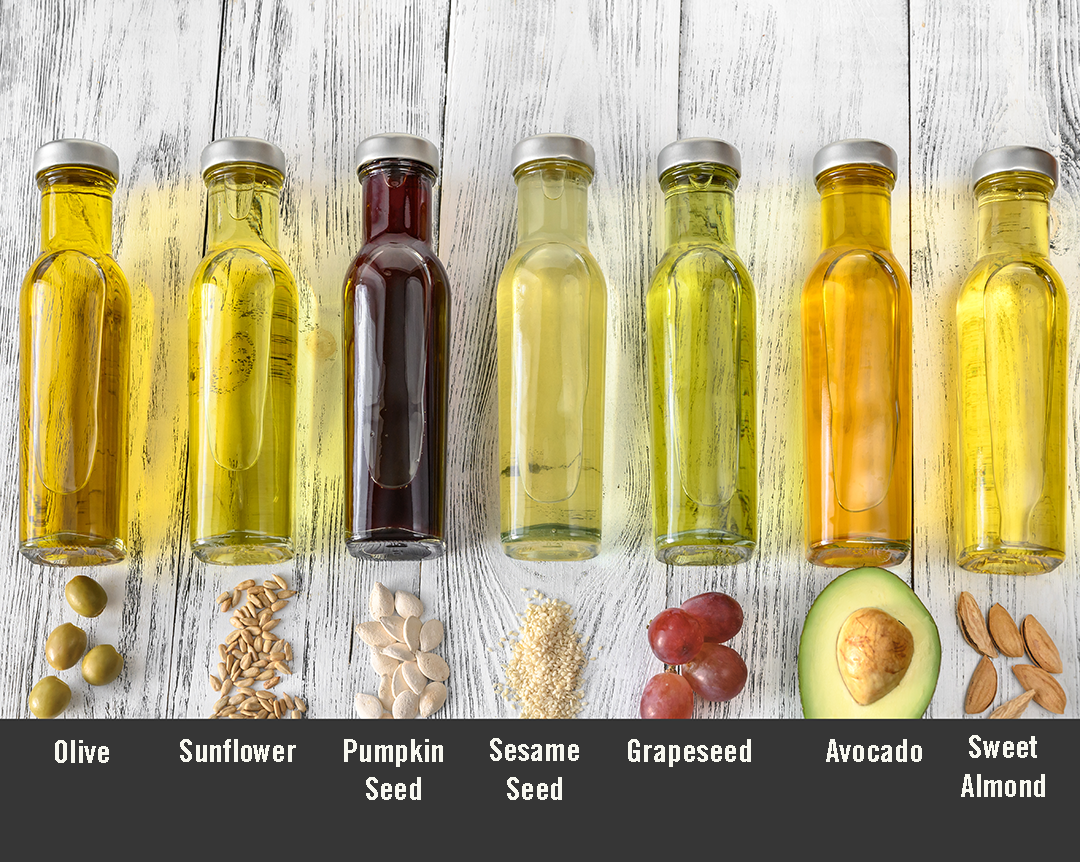
When choosing an oil for your skin, quality is important. Please read the labels.
A high-quality carrier oil will be as natural and as unadulterated as possible. We recommend pure, organic, cold-pressed or expeller-presses, minimally processed unrefined plant-based oils.
These oils have not been exposed to extraction procedures using petroleum-derived solvents, high heat, bleaching, or deodorizing. Although unrefined oils often retain some scent, they also retain lots of nutrients.
Note that if you are creating a product for its aromatherapy benefits rather than its skin-nourishing properties, some carrier oils have a stronger scent and may affect the aroma of your essential oils.
If you are going to purchase some of the more expensive carrier oils it is important to note how long the oil will stay fresh after opening. If you tend to use oils sparingly, buy a small amount, check for expiration dates and look for an oil that has a longer shelf-life.
A Brief List of Carrier Oils
Creating a list of all the possible carrier oils available would be daunting. The following list includes descriptions of some of the popular, easily available, and more affordable carrier oils that can be used to dilute essential oils for aromatherapy, massage, and general skin care. Many of them can be purchased at your local grocery store.
If you have sensitive skin or allergies we always recommend a skin patch test prior to using a new product.
The oil names listed in green indicate that they are linked to our ingredient pages for a more detailed description.
Sunflower Oil
My skin and I love sunflower oil. My skin actually loves all oils high in linoleic acid.
 Sunflower oil is often overlooked in skin care since it lacks the pizzaz of the more expensive oils. It is a very versatile oil, readily available and affordable (even the USDA certified organic brands).
Sunflower oil is often overlooked in skin care since it lacks the pizzaz of the more expensive oils. It is a very versatile oil, readily available and affordable (even the USDA certified organic brands).
Expeller pressed from the seeds, this light oil is easily absorbed and can be used on all skin types, including dry, delicate, normal, and oily.
Rich in essential fatty acids, lecithin, amino acids, minerals, and vitamin E, it deeply nourishes, softens, moisturizes, and conditions all skin types. Since it helps soothe irritation I recommend it for those with super-sensitive skin who suffer from dermatitis, acne, dry, flaky eczema, or psoriasis.
There are two types of sunflower available on store shelves, regular and high oleic. While both are great for skin, the high oleic version is heavier and feels more like olive oil.
It is also important to know that while organic sunflower oil is either cold-pressed or expeller-pressed, most commercial sunflower oil is solvent-extracted to maximize production.
Extra Virgin Olive Oil
Extra Virgin Olive oil is another readily available and affordable oil. It is often overlooked as a carrier oil for two main reasons, scent, and consistency.
A quality extra virgin olive oil has a very distinct aroma that can interfere with the scent of some essential oils. It is also a heavier oil that is best for people with drier skin. I love olive oil for my mature skin on dry winter days. It is high in antioxidants and is exceptionally healing and soothing to dry patchy skin.
Grapeseed Oil
Grapeseed is another readily available oil since has become popular in the world of cooking. It is a very lightweight oil, with a thin consistency that is easily absorbed by the skin and has a neutral scent. Grapeseed oil, suitable for all skin types, is high in linoleic acid and very moisturizing, especially for sensitive or delicate skin.
It is a good carrier oil to make massage or body oils as well as a great oil to help reduce the greasy feel of heavier oils. Be sure to choose the cold-pressed oil since it retains the oil's beneficial properties. Cheaper versions are extracted using higher heat and solvents like hexane.
Avocado Oil
Avocado oil is a wonderfully hydrating oil, rich in fatty acids, and acts as a humectant to help retain and preserve moisture.
It is a heavier oil that absorbs slowly but deeply into the skin due to its high oleic acid content. Due to its thickness, some like to blend avocado oil with thinner oils, such as almond, jojoba, or sunflower. It is an excellent moisturizer for dry, damaged skin, but may be too heavy for acne-prone skin. Quality unrefined avocado oil has a characteristic aroma that can interfere with the scent of some essential oils. As a side note, it is the favorite oil of my massage therapist!
Sweet Almond Oil
 Sweet Almond oil is a moisturizing oil recommended for most skin types, especially inflamed, itchy, cracked, or sensitive skin.
Sweet Almond oil is a moisturizing oil recommended for most skin types, especially inflamed, itchy, cracked, or sensitive skin.
It contains vitamins A and E, minerals, and omega-6 and omega-9 fatty acids, has a light to medium consistency, absorbs well, and has been found helpful for the dry, flaky conditions of eczema or psoriasis.
Although it may have a slightly nutty scent, it is not overwhelming.
Sweet almond oil is one of the most popular massage oils among massage therapists. The "slippery" oil allows hands to glide easily over the skin.
*Caution: Although not a true nut, almonds cause a reaction for those with nut allergies.
Jojoba Oil
Technically, jojoba is not an oil, but a liquid wax. Chemically similar to human sebum (the oil secreted by your skin), it is considered nature's most effective natural moisturizer. A good quality jojoba oil is a rich, golden color.
The oil absorbs easily, does not clog pores, and is a good choice for all skin types even those who have sensitive skin or are prone to acne. Whether your complexion is dry, oily, or a little bit of both, jojoba oil can help balance the skin’s natural oil production. Jojoba has a long, stable shelf-life.
Oils and butters that are solid at room temperatures like unrefined virgin coconut, unrefined cocoa butter, and unrefined shea butter can also be great carrier oils.
 All three of these great unrefined moisturizers have lovely scents of their own which may alter the scent of your essential oils. For me, unrefined or virgin oils and butters are the best. Their minimal processing ensures nutrient-rich, high-quality oils. However, it is definitely a personal preference.
All three of these great unrefined moisturizers have lovely scents of their own which may alter the scent of your essential oils. For me, unrefined or virgin oils and butters are the best. Their minimal processing ensures nutrient-rich, high-quality oils. However, it is definitely a personal preference.
Obviously, these solid fats will need to be melted before adding essential oils. Be aware that essential oils are delicate and quite temperature-sensitive.
If you add essential oils to a warmed melted butter/oil do NOT add them when the oils are hot. The heat will cause the essential oils to evaporate away, destroy the scent, and possibly change the therapeutic benefits of the essential oils.
We usually allow our oils to cool to around 60F (16C). Also, essential oils are flammable, some much more so than others. So be careful with essential oils around open flames.
When working with butters or oils that are solid at room temperature, we suggest adding some liquid oil to help give your product a creamy consistency.
There is also a liquid type of coconut oil, called Fractionated Coconut Oil. Some people really love using it as a carrier oil.
You can find descriptions of all the oils we use on our Ingredients Page.
There are other wonderful unrefined, antioxidant-rich, and skin-nourishing oils that have exceptional skin healing benefits.
Although these oils tend to blend well with essential oils, most unrefined oils have a strong natural scent, a short shelf life, and are often quite expensive. We tend to save these oils for facial products and healing oils. Some examples of these unrefined oils include:
Pomegranate Oil
Pumpkin Seed Oil
Rosehips Oil
Sea Buckthorn Oil
Tamanu Oil
Conclusion
Carrier oils not only make it possible for people to enjoy the benefits of topical essential oils safely, but they also offer their own therapeutic properties that help nourish and moisturize the skin.
When choosing a carrier oil the key is not the price, but the quality of the product.
As I said in the beginning keep in mind the purpose of the product you are creating since each oil has its own unique characteristics and benefits.
When using a carrier oil on your body, you will want to be sure it is appropriate for your skin type. Some oils are lighter and more readily absorbed by the skin while others have a heavier consistency. Additionally, some oils might be gentler on sensitive skin conditions.
There are many affordable moisturizing oils that will have similar effective active components as more expensive alternatives. Do some research on the types of oils that your skin seems to like and then check out their fatty acid content. Depending on their molecular structure and fatty acid composition, carrier oils will vary in texture and benefits.
If you discover an expensive oil that your skin likes, try to find oils with a similar fatty acid profile by searching profiles on the interent.
As I mentioned above my skin generally likes oils that are a bit higher in linoleic acid.
Usually, an oil with a high linoleic acid content tends to be lightweight, thinner, fast-absorbing, and non-greasy. Think sunflower, rosehips, or grapeseed!
While an oil with a high oleic acid content is often heavier, thicker, slower-to-absorb, and possibly more greasy. Think olive or avocado oil!
I know that I often repeat myself, but you are unique and so is your skin. Often finding the right carrier oil, just like any skincare product, becomes a matter of trial and error. Your skin needs will also change from season to season and as you age.
In all my years of working with natural skincare, my skin's preferences for products that it should NOT like never cease to amaze me.
Have you tried any of these oils? Do you have a favorite carrier oil? Please share!

Why We Use Only Real Plant Essential Oils?
How Essential Oils Are Extracted
Essential Oil Basics: A Guide To Dilution Rates
How to Diffuse Essential Oils for Personal Use
Natural Fragrance Oil? . . . Really?
How To Do A Simple Allergy Patch Test
The information above pertains to healthy adults. We do not provide information on the safety of essential oils during pregnancy or for use in Children because the available information is often contradictory. If you are interested in using essential oils during pregnancy or with young children please do your own research and be sure to consult your doctor, midwife, or health care professional before use.
The statements regarding health-related benefits of essential oils have not been evaluated by the Food and Drug Administration and are in no way intended and should not be construed as medical advice to diagnose, treat, cure, or prevent any disease or health condition.
